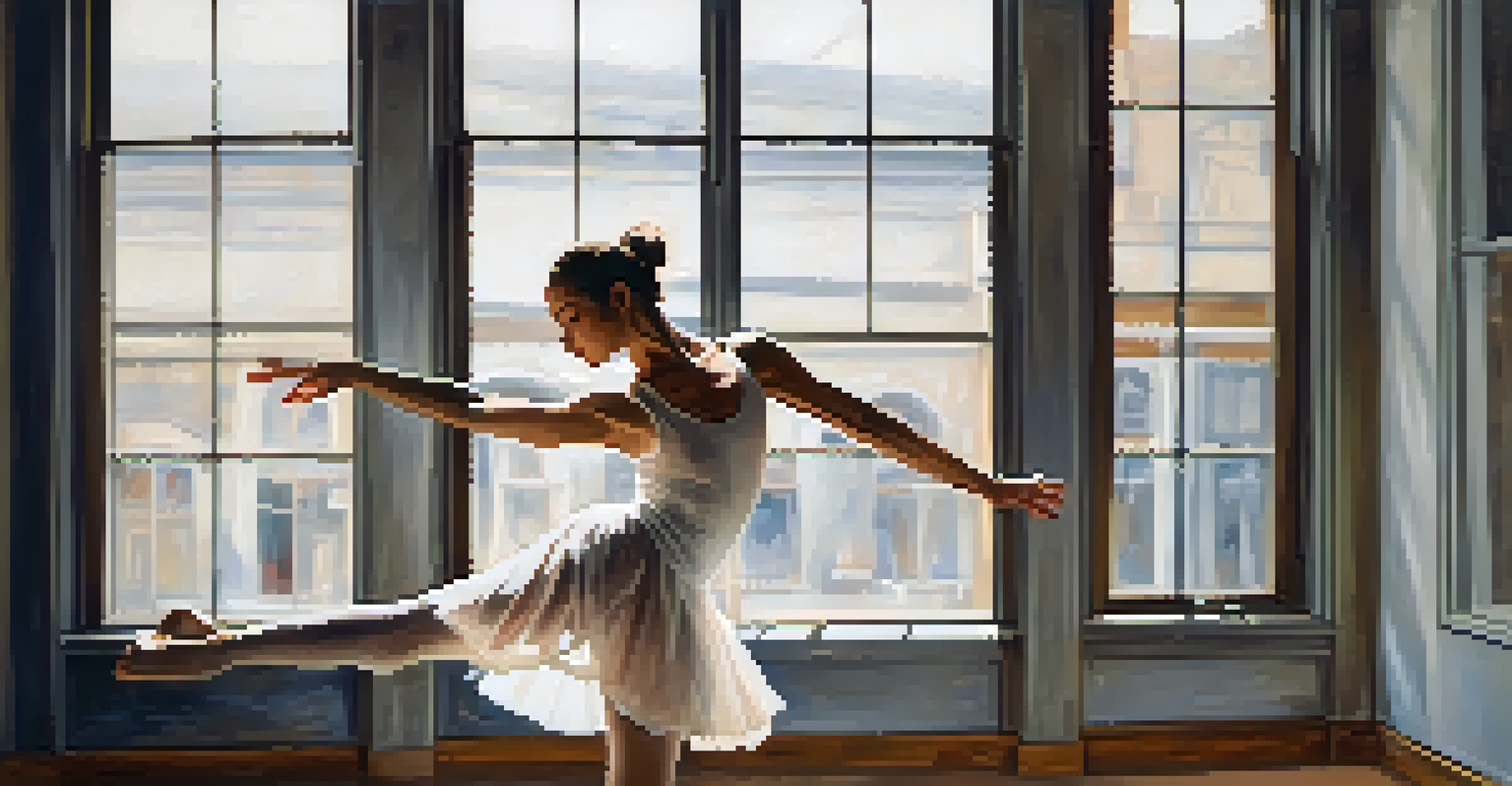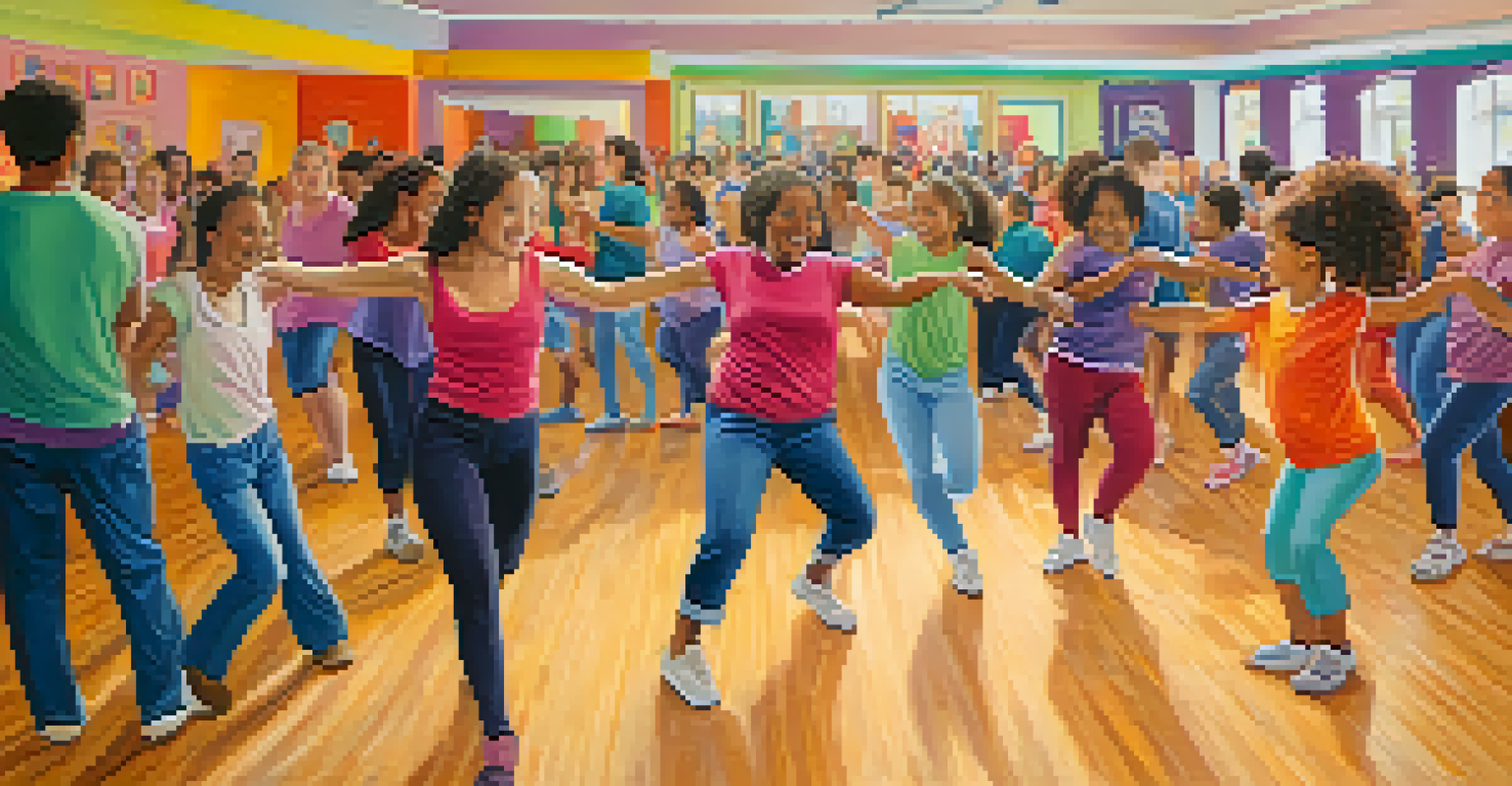How Dance Improves Body Image and Self-Perception

The Connection Between Dance and Body Image
Body image refers to how we perceive our physical appearance, and dance can significantly influence this perception. When we engage in dance, we learn to appreciate our bodies for their abilities rather than focusing solely on appearance. This shift in focus can lead to a more positive body image.
Dance is the hidden language of the soul.
In dance, every movement is an expression of creativity and emotion, which helps individuals connect with their bodies in a nurturing way. This connection can be empowering, allowing dancers to embrace their unique shapes and sizes. Consequently, this fosters a sense of confidence and pride in one’s body.
Moreover, dance encourages acceptance of imperfections. As dancers, we learn that everyone has strengths and weaknesses, and that’s part of what makes us human. This understanding can translate into a healthier self-perception beyond the dance floor.
Physical Movement and Mental Well-being
Engaging in dance is not just a physical activity; it significantly impacts mental health as well. Physical movement releases endorphins, which are chemicals in the brain that act as natural mood lifters. This can lead to improved self-esteem and a more positive outlook on one’s body.

Furthermore, dance can serve as a form of self-care, offering an outlet for stress relief and emotional expression. When we dance, we often forget our worries, focusing instead on the rhythm and flow of movement. This distraction can lead to a more positive self-image as we learn to love ourselves in the moment.
Dance Boosts Body Image
Engaging in dance fosters a positive body image by encouraging appreciation of one's physical abilities and uniqueness.
Additionally, the social aspect of dance can enhance feelings of belonging and acceptance. When we dance with others, we often find community and support, which can reinforce positive feelings about our bodies and selves.
Dance as a Form of Self-Expression
Dance is a powerful medium for self-expression. It allows individuals to express their emotions, thoughts, and stories through movement, which can be incredibly liberating. This freedom encourages dancers to embrace their individuality, enhancing their self-perception.
The body says what words cannot.
When people dance, they often experience a sense of joy and empowerment that comes from expressing themselves authentically. This feeling can translate to a more positive view of oneself, as individuals start to appreciate their unique qualities. In dance, there is no 'right' or 'wrong' way to move; it's all about personal expression.
Furthermore, creative expression in dance can help individuals process emotions and experiences. This therapeutic aspect of dance fosters a deeper understanding of oneself, leading to enhanced self-acceptance and a healthier body image.
Building Confidence Through Dance
Participating in dance classes or performances can significantly boost confidence levels. As individuals learn new movements and showcase their skills, they gain a sense of accomplishment, which can enhance their self-esteem. This newfound confidence can spill over into other areas of life.
Moreover, overcoming challenges in dance, such as mastering a difficult routine, reinforces a sense of resilience. Each success, no matter how small, builds a foundation of self-trust and belief in one's abilities. This process of growth fosters a healthier self-image.
Mental Health Benefits of Dance
Dance serves as a powerful outlet for stress relief and emotional expression, enhancing overall mental well-being.
Additionally, receiving positive feedback from instructors and peers during dance can further enhance confidence. Being recognized for hard work and dedication helps individuals feel valued and appreciated, which is crucial for a positive self-perception.
The Role of Community in Dance
The dance community can be a powerful support system for individuals seeking to improve their body image. Being part of a group that shares similar interests fosters a sense of belonging, which can enhance self-worth. This community support reinforces the idea that everyone is unique and valued.
In group dance settings, individuals often celebrate each other’s differences and strengths. This collective appreciation encourages a positive atmosphere where everyone feels accepted, regardless of their body type. Such environments can significantly improve self-perception over time.
Moreover, friendships formed in dance classes often extend beyond the studio. These connections provide emotional support and encouragement, further boosting confidence and body image as individuals navigate their personal journeys.
Dance and Body Positivity Movement
The body positivity movement, which promotes acceptance of all body types, has found a natural ally in dance. Many dance companies and initiatives focus on inclusivity, showcasing dancers of all shapes, sizes, and abilities. This representation is crucial for fostering a more positive body image among participants and audiences alike.
By celebrating diversity in dance, individuals begin to see that beauty comes in many forms. This realization can challenge societal beauty standards and encourage self-acceptance. Dance becomes a platform for advocating body positivity, inspiring individuals to embrace their authentic selves.
Community Supports Self-Acceptance
Being part of a dance community cultivates a sense of belonging and acceptance, reinforcing positive self-perception.
Additionally, workshops and classes that emphasize body positivity help participants explore their own self-worth. These settings encourage individuals to focus on what their bodies can do rather than how they look, promoting a healthier mindset overall.
The Lifelong Benefits of Dancing
The benefits of dance extend far beyond the dance floor. Engaging in dance regularly can lead to a lifelong appreciation for movement and physical health, which contributes to overall well-being. This appreciation can help maintain a positive body image over time.
As individuals grow older, they may face societal pressures regarding body image. However, those who dance often possess a resilient mindset, reminding themselves of the joy and freedom that movement brings. This mindset can be a powerful tool in combating negative self-perception.

Ultimately, dance instills a lifelong love for one’s body and its capabilities. By fostering a positive relationship with our bodies through dance, we can navigate life with confidence and self-acceptance, celebrating every stage of our journey.